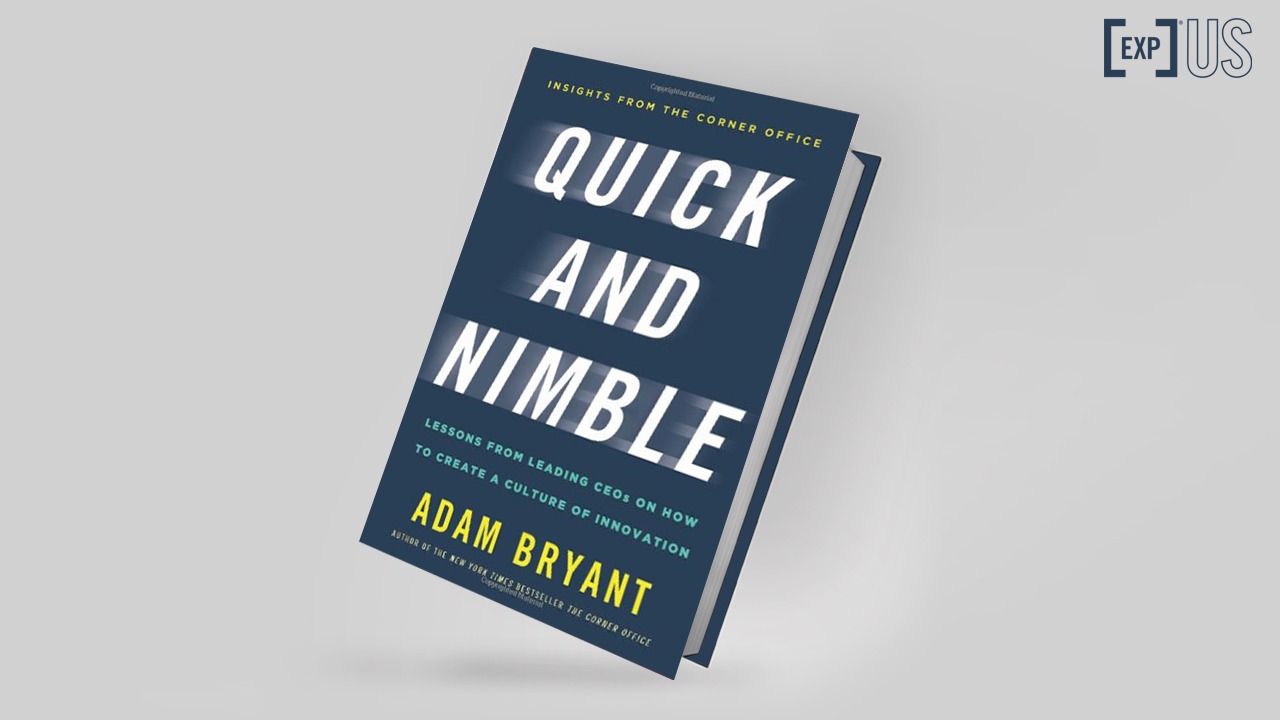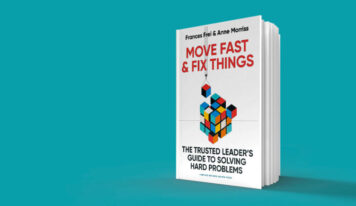The insights of great CEOs on how to create successful companies
Central Ideas:
1 – As a director of a company whose focus is culture and understanding culture, I need everyone in the organization to have a primary and a secondary area of interest. They are linked together and both are part of the creative process (Steve Stoute, Translation LLC).
2 – I developed the ability to work in a team because I started to let go of the credit, in an environment where everything is geared towards it. I realized that people liked it when you played for the result and not because of your role on the team (John Donovan, AT&T).
3 – The starting point [Google’s Oxygen Project] was the realization that our most effective leaders’ teams perform better, stay longer in their jobs, are happier – do everything better [Laszlo Bock, Google HR].
4 – After a certain point [in the meeting], people switch off and don’t care what is said. If you go into a meeting where someone is talking for more than fifteen minutes, 90% of the people are going to be checking their cell phone (Joel Babbit, from the Mother Nature Network website).
5 – The companies that will prosper in the long term are those that understand that culture is a fundamental element of their strategy – to attract and retain the best talent, to stimulate employees, and to foster a favorable environment for innovation.
About the author:

Adam Bryant is the author of The Corner Office: Indispensable and Unexpected Lessons from CEOs on How to Lead and Succeed. He writes the popular “Corner Office” column for the New York Times, and has served as senior editor of the paper’s signed articles section, deputy national editor, and deputy senior business editor.
Introduction
Discussions about corporate culture can easily fall into platitudes, theories, truisms, and generalities. Generic approaches don’t work either, for the simple reason that every organization has a unique culture, just as every country is different from another. With this in mind, I set out to find practical tips and insights that would be useful and relevant to any organization – the kinds of approaches that would help develop the culture that Jenny Ming imprinted on Old Navy, where she turned the brand into the locomotive of retail.
Readers will notice that some insights in this book impact more than others. This is to be expected, as every business culture is different, with its specific challenges and strengths. As with leadership, we all need to understand the business culture for ourselves, in a way that feels authentic to our organization. The leaders I interviewed have hundreds of years of experience and knowledge. I am sure their intelligent insights will help readers make their own companies more agile and innovative so that they can thrive in a relentlessly challenging global economy.
PART ONE – Define the Fundamentals
Chapter 1 – Why Culture Matters
When I talk to Wall Street, what people really want is to know your results, what your strategies are, what the problems are, what you are doing to run your business. To them what matters are the final numbers. Nobody ever asks about the culture, the leadership and the employees of the organization. However, it is the opposite that is important, because it is the people, the leadership, the culture and the ideas that ultimately produce the numbers and the results.
This is why culture is important. A supportive culture is like a greenhouse in which people and ideas can flourish – in which everyone in the organization, regardless of level or position, feels encouraged to speak up openly and frankly, and is rewarded for sharing ideas about new products, more effective procedures, and better ways to satisfy customers.
The challenge for leaders is to create a culture that preserves this energy and removes the forces that cause people to shut down and dream of changing jobs. Marjorie Kaplan, president of the cable networks Animal Planet and Science, often talks to her assistants about the need to keep alive the flow of energy that people bring when they start in a new job what she calls their “best selves.”
“I think part of the managerial activity is bringing people together. I want them to have the courage to put their ideas out there. In fact, it’s like saying, ‘Bring your best. Bring out your best every day when you come to work. Bring your best to the conversations. Bring your best to the presentations. And we will give you something in return. We are investing in you. You are investing in us, and we are investing in you.”
Chapter 2 – A Simple Project

Of course, there is no formula that sums up strategies and priorities. Every company is unique, and every leader has to figure out a handful of goals and parameters that get everyone rowing in the same direction, knowing clearly how their work contributes to achieving the goals. As in countless aspects of life, it is difficult to simplify things. However, crafting a simple proposal can bring enormous reward, and misinterpreting it, with people focusing on goals that don’t move the organization forward, can have a discomfiting impact. As Peter Drucker once said, “What you can evaluate, you can manage.”
Tracy Strekenbach was a consultant with Ernst & Young and is currently CEO of Hillview Consulting. She has seen from personal experience the importance of a simple project; for her, a simple project is more important than a passionate mission statement.
“Honestly, I think the mission statement is less important than each employee understanding what the company’s positioning is,” says Streckenbach. “To me, the mission statement can be something impractical. I need to effect change quickly and generate results. When I arrive at a company and ask ten top executives what they consider unique about the company, the answers are very different, sometimes even conflicting. Therefore, the simple fact that everyone has the same perception of the company’s positioning is more important than the mission. Culture is related to performance and the sense of well-being that people have as a result of how they contribute to the whole.”
Shivan S. Subramaniam, CEO of FM Global, a commercial and industrial property insurer, says, “Over the years activity has meant that we have had very simple goals in the company. We call them key result areas (KRAs). We have three CRAs, nothing too fancy, and everyone focuses on them. One is profitability. Another is retaining existing customers. And the third is attracting new customers.”
Chapter 3 – Ground Rules
In my interviews with hundreds of CEOs, two general rules emerged:
No. 1: There is no “right” way to create values. Values can come from the leaders themselves or they can be created through input from all employees in the company (or a mixture of the two).
No. 2: The company must live by the announced values, reinforce them daily, and not tolerate behavior that is contrary to them.
Here’s why: if employees begin to perceive that there is an inconsistency between the values proclaimed and the behaviors tolerated, then the whole effort of creating clear values will hurt the organization, because it will cause people to become disengaged, give a despondent look, and wonder why on earth they expect this time would be different.
Steve Stoute describes the method he uses at Translation LLC and Carol’s Daughter: “Another important value is that people have to have a primary and a secondary area of interest. I don’t want the person to use only her academic background with her co-workers. If she is a photographer, a DJ, or a blogger, I want these skills to be part of the work that she does within the company. As a director of a company that focuses on culture and understanding culture, I need everyone in the organization to have a primary and a secondary area of interest. They are linked together, and both are part of the creative process.
Chapter 4 – A little respect
Richard R. Buery Jr. CEO of the Children’s Aid Society, said that a bad experience with a former supervisor provided him with extra motivation to seek a leadership position so that he could influence the culture.
“One leadership lesson I learned – and one that falls into the category of “obvious” – is the critical importance of being a good person and treating others well,” he said. “I remember that in one of my temporary lawyer jobs I had, there was a boss who would call me out in front of her colleagues. And while I think she was fundamentally wrong, that wasn’t the point. As a colleague, she should have had enough consideration for me to come up, talk to me – even though she was a boss – and say, ‘Look, we need to have a private conversation. I think you should have done this, but you didn’t.’ And that never left my mind. To be honest, one of the reasons I wanted to be an entrepreneur was that I didn’t want to have nasty bosses anymore. I wanted to create an environment where it wasn’t normal to treat people that way.”
Robin Domeniconi, former head of branding for Elle Group, said he uses the term “IMR” as a cultural foundation.
“I learned a lesson from an acronym called IMR, which stands for ‘the most respectful intepretation’ of what someone tells you. I don’t need everyone to be a friend, but I do need my team to have IMR. That way you can say anything to anyone, as long as you say it in the right way. Maybe you need to make an introduction like, ‘Just out of curiosity, I would like to better understand what you are saying. Right now I have a very different point of view. So, could you help me understand why you don’t want to do this, or why you wanted to do this?”
Chapter 5 – It’s the team that matters
This is a lesson that Peter Löscher, CEO of Siemens, learned when he was captain of the volleyball team in high school and college. “I think the fundamental principle of the business world is trust. How do you implant within the team a blind trust that makes each individual play for the other? A company is nothing more than a group of leaders or people gathered around a cause or focused on a certain goal. Nevertheless, the fundamental strength is trust within the team; so that you are actually no longer just giving your best individually, but also trying to understand what you can do to make the team better.”
John Donovan, chief technology officer at AT&T, said that his approach to work changed when he learned to stop worrying about whether or not he would get credit for his successes.
“I developed the ability to work as a team because I began to deliberately give up credit in an environment where everything is geared toward it,” he recalled. “I started to realize that people liked it when you played for the result and not because of your role on the team. So I learned there that giving up credit was an effective gesture. I think I learned a lot of subtleties about teams and how to put them together.”
Chapter 6 – Adult Conversations
“A big part of my growth as an administrator has to do with overcoming my own insecurity and the fact that I gained confidence,” said Seth Besmertnick of Conductor. “When you feel confident, you can give feedback to people, you can be honest. You feel secure enough to say what you really think, to call someone in your living room and say, ‘You did this. And that really made me feel XYZ. The ability to have fruitful conversations actually represents eighty percent of what defines an effective administrator.”
At Proteus Digital Health, Andrew Thompson has created groups to work on various aspects of the company culture. One of the groups is focused strictly on feedback, teaching people how to talk to each other about their performance in a respectful way. The group uses the striking image of the tennis player “crossing the net” as a reminder of the rules for giving feedback.
One of the challenges we wanted to address,” Thompson said, “is that we wanted to be a company where people could talk openly with each other, rather than letting the situation deteriorate or going to the boss to say, ‘I can’t work with Fred because of this or that. It’s much easier to go to Fred and say, ‘Hey, look, when you do X I feel Y.’ So now everybody in the company is trained in how to give feedback.
Chapter 7 – The Perils of Email

The problem, of course, is that despite the obvious advantages of e-mail in speeding up communication, it is also a dangerous trap. It is very easy to misinterpret an e-mail, which often brings disastrous consequences for the organization’s culture.
Many CEOs are very aware of the dangers of e-mail, so they set up a variety of rules to discourage its use and instead encourage people to talk to each other.
Here’s what Steve Stoute of Translation LLC and Caol’s Daughter tells his team:
“I let everyone understand that everyone is directly responsible for the person working alongside them, and that it is very important that we are transparent with each other, that we work in sync, and that we communicate consistently and clearly. I force people to talk to the person who works beside them instead of sending e-mails. The advent of email has created a huge increase in productivity, but as the tone has been lost, it has also created a much larger amount of misunderstandings.”
Ori Hadomi, CEO of medical technology company Mazor Robotics, established a rule to prevent employees, especially those working in different offices, from getting into arguments over email.
“Email is a very dangerous form of communication,” he said. “Although it has a number of benefits and advantages, I think it is dangerous because in the case of conflict and disagreement, when they start arguing over email people stick even more to their opinion.
“Disagreeing over email is really not constructive. It’s not the right way to communicate when you want to reach an agreement. So I insist on this rule: let’s just talk or pick up the phone. Also, whenever possible I try to use video. I want to look the person in the eye, especially when we disagree.”
SECOND PART – How to take leadership to the next level
Chapter 8 – Repeat as often as necessary
“The leader needs to be a careful person, especially in a large organization,” said Christopher J. Nassetta, CEO of Hilton Worldwide. You end up relaying the same information so many times that you get tired of hearing it. One way out, therefore, is to change the way you deliver it, or to deliver it more briefly, because after you have literally repeated the information so many times, you find that there is no one else in the world that wants to hear it. But you can’t stop doing it. In my case, since there are three hundred thousand people who need to hear it, it cannot be repeated enough. So what may seem banal and familiar to me, to many people is not. That was an important lesson that I learned when I worked in larger organizations.”
Here is the statement of Amy Gutmann, dean of the University of Pennsylvania:
“Also, I really believe in all kinds of communication: walking around the university, emailing, calling, visiting people, especially at their workplaces. So that I started randomly walking by rooms that I would otherwise never walk by, thanking people who had accomplished something exceptional; but also asking them, ‘What’s the thing you’re most proud of?’ I ask these kinds of questions for two reasons: because I’m sincerely interested in the answer, but also to check whether our most important priorities are resonating with the lower echelons of the organization.”
Chapter 9 – Shape more effective leaders
In early 2009, Google launched the Oxygen Project with a single goal: to train more efficient managers. This project came about as a result of a data analysis effort by the human resources department, which discovered, by analyzing quarterly performance appraisals, that the ratings employees gave their bosses varied enormously. Managers were the most important factor in employee performance and how they felt about their work.
“The starting point was the realization that the teams of our most effective managers perform better, stay longer on the job, are happier – do everything better,” said Laszlo Bock, senior vice president of “people operations,” which is the name of the human resources department in Google’s language. After many studies, statistics and reports, the Oxygen Project has made a list of the eight behaviors of effective managers:
– Have a clear vision and strategy for the team.
– Help your employees grow professionally.
– Don’t be shy: be productive and go for results.
– Have clear technical skills so you can guide the team.
– Be a good communicator and listen to your team.
– Show interest in the success and personal well-being of your team members.
– Delegate power to the team and don’t worry too much about details.
– Be a good coach.
“In the context of Google, we always believed that to be an administrator, particularly in the engineering sector, you had to be as or more specialized than the technicians who work for you,” Bock said. “It turns out that that is by far the least important thing. It is important, but comparatively it is less important. Much more important is being able to relate and be an approachable person.”
Chapter 10 – Bring up the issues
Dennis Crowley of Foursquare asks employees at the coffee shop how he can do his job better.
“As the company has grown, I sometimes start to feel disconnected from people, and I randomly decide to meet with one person a day, and we go out for a half hour of coffee,” he said. “You just have to act like that for six weeks or so for all the communication channels to become free again. People feel they can approach and talk to me. I get all about the things that worry or challenge them, or the questions they might have. And I also always ask them for feedback-‘Is there anything I can do to improve the company?'”
Ori Hadomi of Mazor Robotics has found that assigning someone to play devil’s advocate helps avoid panelism in meetings.
“Before setting the next year’s goals, we follow a tradition: we define the five biggest mistakes we made in the year just ending – and we focus on the big mistakes, not the small ones. Moreover, every year we check whether these mistakes have anything in common. Then we set goals for the following year,” he said.
“One of the most obvious mistakes we make is that we often and often prefer to believe in an optimistic scenario: our thinking is overly positive. To some extent, positive thinking is important, when you need to motivate people and show them the possibilities that the future brings. However, it is very dangerous when planning is based on it. Therefore, one of the lessons this taught us was that it was necessary to appoint one of the CEOs as devil’s advocate. In fact, he is very provocative. He really makes a point of saying to me, ‘We’re going to have to be humble about our claims. And the most surprising thing is that he is the vice president of sales for international markets.”
Chapter 11 – One never stops learning

“If you look at why people often leave companies, you’ll find that it’s often because of boredom,” said William D. Green, former board director and former CEO of consulting firm Accenture. “Also, people who perform above average are learners by nature. And as long as they are learning, they stay where they are. When they start thinking about leaving, when they start answering the headhunter’s call, it’s because they’ve stopped learning.”
Irwin Simon of Hain Celestial Group said he tries hard to make sure people don’t get stuck in their roles.
“I learned within corporate America that people are put in a box – you’re either an accountant or you work in marketing; and, basically you get labeled the rest of your life,” he said. “That’s why I love taking someone from marketing and putting them in finance, or taking someone from finance and putting them in marketing. I believe it works to take people out of the box, get them out of their comfort zone, and put them in other sectors. That’s how you grow in life. Look at the amazing opportunity you have. I love people who go and live in other places in the world just to see what it’s like. I try to encourage people to do and know other things. I believe deeply in the idea that you have to stimulate people. If you don’t stimulate them, they get very complacent.”
Chapter 12 – The Art of Making Smarter Meetings
Carl Bass, CEO of software creation company Autodesk, explains his method:
“One of the things we do is to be extremely clear about decisions, because there is an implicit tension between listening to people’s opinions and them thinking that everything is decided democratically. In some meetings, I say frankly that although the decision is mine and mine alone, I would like to hear everybody’s opinion. At the beginning of every meeting, we make it very clear when the decision rests with one person or when it is more of a discussion to reach a consensus. I think it’s very important to understand that, because otherwise people may be disappointed that they have given their opinion without, however, knowing the broader context in which the final decision was made.”
Joel Babbit, CEO of the Mother Nature Network website, always runs short, objective meetings.
“I’m probably the person who runs the shortest meetings. Sometimes I just answer yes or no and I’m out of the room,” he said. “Since I have attended some torturous meetings, mine are likely to be too short. At the same time, however, I believe that most meetings could have their time reduced to a third and yield much more. After a certain point, people switch off, caring little about what is being said. If you go into a meeting where someone talks for more than fifteen minutes, ninety percent of the people will be consulting their Blackberry [cell phone] instead of paying attention.”
Chapter 13 – Put an end to cliques
Chauncey Mayfield of MayfieldGentry Realty Advisors has implemented a performance appraisal system that reflects the work of employees across the organization, not just what they do for their immediate superior.
“What we’re finding – and what I’ve found in other companies – is that people start forming cliques, and the only thing that’s important to them is what happens in the cliques,” he said. “So this clique is not wanting to work with that clique, and now you have almost antagonistic factions within the company. They have no desire to work together, because there is no penalty for not doing it and no incentive to do it. So, as the company has grown, I have tried to prevent these cliques from growing, because I firmly believe that they end up destroying the company. That’s probably one of the biggest challenges I’ve faced – how to prevent the emergence of cliques.”
Kathleen Flanagan of Abt Associates redid the organization chart when she took over her consulting firm.
“As the company grew, more business units were created, which led to a growth in the number of cliques,” she said. “My goal was to do away with them, so I reorganized the company. It was organized around lines of business – international, US-based, and data collection – and there were senior vice presidents in charge of each of these huge areas. I fired the senior vice presidents and hired an executive vice president for the entire company who shared my vision of what I call a Global Abt.”
Daily breaks can also help break up the little panels.
“The little things are important,” said Doreen Lorenzo of Frog Design. “We have many rituals. One is called coffee hour: every day at four in the afternoon in each of our studios around the world, everyone stops what they are doing and goes to socialize in the kitchen. They can play ping-pong, video games, pool, and foosball. Each studio has one type of game. It’s a ritual accepted by everyone; that’s our way.”
Chapter 14 – The brilliance of innovation
Ronald M. Shaich, director of the board and co-CEO of Panera Bread, has created a simple model to reflect on how companies function. According to him, organizations have two muscles: the “production muscle,” to get work done, and the “discovery muscle,” to seek innovation. However, as he explained, many organizations take an unbalanced approach:
“We have not been struck by something that happens in so many large companies: allowing the ‘production muscle’ to take absolute precedence over the ‘discovery muscle.’ Of course, the production muscle seems rational, people feel much more secure with it, and moreover it can be analyzed. It is driven by market research, which tells me what I can count on, and is quite suitable for gradual change. But when we refer to companies that discover new patterns, that are innovative, it is an act of faith. It’s about trusting yourself. It’s about innovating. It’s about believing that you are capable of figuring out where the world is going and that you will get there, and then saying let’s go left and not right. Decisions are not necessarily rational or easy to defend. Still, you have to take that approach.”
Jen-Hsun Huang, CEO of graphics chip producer Nvidia, said that the attitude of taking risks and learning from mistakes has become part of the company’s basic values.
“Let me mention the two elements that I cherish most among our basic values and that I have spent a lot of time fostering. One is the sympathy with risk takers and the ability to learn from failure. The ability to celebrate failure, so to speak, has to be an important element of any company operating in a rapidly changing world. The second basic value is intellectual integrity – the ability to name names, to recognize as quickly as possible that a mistake has been made, that we are on the wrong track, learn from it, and adapt quickly.”
Chapter 15 – How about a little fun?

So what are the secrets to having fun at work?
In a way, trying to answer the question is like trying to explain a joke: you can try to analyze why something is funny, but ultimately the humor is in the timing and the way you tell the joke. Some companies have pajama day or dance Fridays (short breaks where everyone dances in the hallway). Also, given the number of CEOs who have reported to me how much their employees get involved with the costumes and office decorations, Halloween seems to be the holiest day in American companies.
Cathy Choi of Bullbrite said that employees didn’t have to go far to find a teamwork practice during the holiday season.
“Every Christmas we do a lighting contest; After splitting into pairs, people have half an hour to make the decoration; then we hang each decoration on the tree and give out prizes like ‘Good to be recycled,’ which basically means the ugliest of all. It turned into something very competitive.”
At Angie’s List, the company uses the parking lot to hold an annual contest.
“On the Friday before Memorial Day weekend, we hold a race for cars made out of soap boxes, dividing the company into teams made up of employees from all departments,” Angie Hicks said. “So we end up meeting people we don’t normally work with. So that morning you end up building a race car made out of soap box with the seventy dollars each team received to buy raw materials. The race takes place in the afternoon in the parking lot, which has a slight slope. Some of our vendors even fly in to participate.”
Chapter 16 – Alone at the top
One of the biggest challenges leaders face is finding the right balance when creating a sense of urgency and change. If change is too much and too fast, the company will be overtaken by the competition. Many leaders have mentioned the importance of being consistent, ironing out the edges, and setting the right pace for change.
Words of Harry West from Continuum: “I had a tendency to overestimate the amount of change I can accomplish in the short term, and then not fully appreciate the change I can accomplish in the long term. I then learned that it is critical to think carefully about the pace of change, only I learned the hard way. It’s important to deal with it carefully, because it’s not just about the pace of change that is convenient for certain employees in the company; it’s about the pace of change that is convenient for the company as a whole. You can push and push and nothing seems to happen; then, suddenly, the thing takes off and you kind of run after it.”
Effective cultures are based on trust – among colleagues and in the organization’s board of directors. To bring their “best selves” to work, employees have to trust that all the organization’s rules – explicit and implicit – are for real, and that the leaders will honor their word.
Employees know that bosses make mistakes and that they may suddenly have to change direction because of a strategy that didn’t work out. But they have to feel that the manager is a person of trust and integrity who respects his subordinates – and that every decision, even when not popular, is at least in the best interests of the organization.
The top of the company is a lonely place. While leaders of many organizations may hear the opinions of the board of directors or the executive team on important strategic decisions, on many occasions they can only rely on themselves to make delicate evaluations – to make sure that the team consists only of the best employees, to dictate the pace of the organization, and to make decisions that inspire respect, security, and confidence. Such occasions can leave some people distressed, while others are drawn to them.
Conclusion
The companies that will prosper in the long term are those that understand that culture is a key element of their strategy – to attract and retain the best talent, to encourage employees to bring their best to work, and to foster an environment in which everyone is motivated to innovate. At a time when the global economy presents more challenges for leaders, those who create an agile and innovative culture will be the winners.
Fact Sheet:

Title: Agile and innovative – CEOs teach how to create successful companies
Original Title: Quick and nimble: lessons from leading CEOs on how to create a culture of innovation
Author: Adam Bryant
![[Experience Club] US [Experience Club] US](https://experienceclubus.com/wp-content/uploads/2021/03/laksdh.png)










![[Experience Club] US [Experience Club] US](https://experienceclubus.com/wp-content/uploads/2021/03/logos_EXP_US-3.png)







